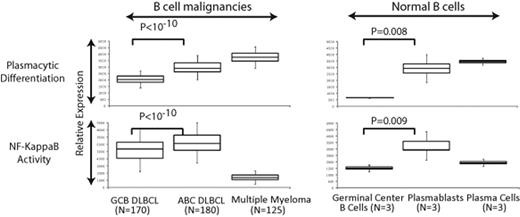Abstract
Abstract 621
The classification of leukemias and lymphomas is based upon the state of differentiation of hematopoietic cells from which the malignancy is derived. These malignancies frequently preserve aspects of their lineage and lineage-specific markers are a standard in the pathology diagnosis of these tumors. Diffuse large B cell lymphoma (DLBCL) is the most common form of non Hodgkin lymphoma and comprises at least 2 different molecular subsets. The first subset is derived from germinal center B cells (GCB DLBCL) and is characterized by a relatively good prognosis when treated with standard chemotherapy. The second subset, activated B cell like (ABC) DLBCL, is characterized by higher expression of plasmacytic genes (IRF4, PRDM1 and XBP1), an activated phenotype and poorer prognosis. Unlike multiple myeloma, ABC DLBCLs lack the morphology and phenotype of plasma cells. The normal B cell counterpart of ABC DLBCLs is unknown.
Thus, there are 2 major aspects of the molecular phenotype ABC DLBCLs—first, ABC DLBCLs demonstrate features of plasma cell differentiation, suggesting that they are derived from post-germinal center cells that are undergoing plasmacytic differentiation. Second, ABC DLBCLs are characterized by high activity of the NF-KB pathway, which is responsible for their activated phenotype. The etiology of NF-KB activation is not known, but is thought to result from acquired mutations in genes that encode the NF-KB pathway.
Although plasmablasts have been studied extensively in vitro, using a variety of techniques to induce plasmacytic differentiation, comprehensive studies of in vivo, lymph node-derived human plasmablasts have been lacking.
Using flow cytometry for a standard set of B cell markers (CD19, CD20, IgD, CD38, CD27, CD10, CD138), we identified mature B cell subsets including naive, germinal center (GC), memory, plasmablast (PB) and plasma cells (PC) from healthy patients undergoing routine tonsillectomy. These subsets were profiled for gene expression at the whole genome-level and we constructed Bayesian predictors to distinguish these subsets. These gene expression-based predictors could distinguish the normal B cell subsets perfectly. We then applied these Bayesian predictors to identify the lineage of 350 tumors from patients with DLBCL and 125 patients with multiple myeloma. Tumors with ABC and GCB DLBCLs were distinguished based on their gene expression profiles. Using the Bayesian gene expression predictors, we found that GCB DLBCLs were classified as germinal center B cells, whereas ABC DLCBLs were classified as plasmablasts and multiple myeloma cases were classified as plasma cells. We found over 90% concordance between the lineage-based (PB vs GC) predictor and the previously defined gene expression-based predictor that distinguishes ABC from GCB DLBCL (P<1E-10, chi-squared test).
Notably, PBs demonstrated lower expression of BCL6 and CD10, and higher expression of IRF4 and PRDM1 compared to GC cells. The expression pattern was reversed when compared to plasma cells. Thus, the gene expression profile of PBs was intermediate between germinal center (GC) and plasma cells (PC), with regard to expression of genes related to plasmacytic differentiation (p=0.008, Figure 1A).
We further investigated the expression of the NF-KB pathway in these B cell subsets and DLBCL and multiple myeloma. We found that higher expression of NF-KB in ABC DLBCL compared to GCB DLBCL and multiple myeloma reflects the differences in NF-KB activity of their normal counterparts, results that were highly statistically significant (p=0.009, Figure 1B).
Thus the higher expression of genes related to plasmacytic differentiation as well as NF-KB activation in ABC DLBCL appears to be directly related to their origin from plasmablasts.
The key aspects of the molecular phenotype of ABC DLBCLs, i.e. plasmacytic differentiation and NF-KB expression, are a direct reflection of their normal counterpart B cells. Our data provide the basis for a better understanding of the pathogenesis of DLBCL.
No relevant conflicts of interest to declare.
Author notes
Asterisk with author names denotes non-ASH members.


This feature is available to Subscribers Only
Sign In or Create an Account Close Modal